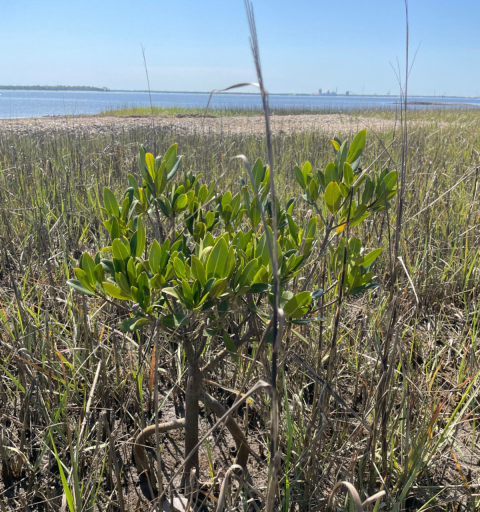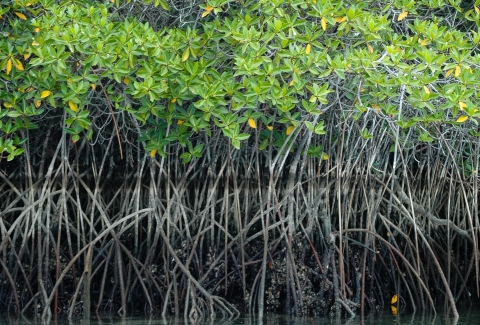Ches Vervaeke, a coastal ecologist with the National Park Service, was cruising along the St. Marys River in January when he saw them.
“Holy cow,” he recalled saying, “there are mangroves in Georgia.”
Mangroves? The tropical plant that shrouds the coastlines of Florida, the Caribbean, and Central America in shadowy, impenetrable greenery? The swamp-loving bushes with tangles of reddish roots that disappear into salt water? The so-called “walking trees” that, apparently, have now skipped up the east coast from Florida into Georgia?
Yup.
And the consequences are fascinating, and far-reaching.
“This is climate change climate change
Climate change includes both global warming driven by human-induced emissions of greenhouse gases and the resulting large-scale shifts in weather patterns. Though there have been previous periods of climatic change, since the mid-20th century humans have had an unprecedented impact on Earth's climate system and caused change on a global scale.
Learn more about climate change , there’s no denying it, this is proof,” Vervaeke said. “You can take the public out and show them the trees that are not supposed to be here. These are tropical plants migrating north because of climate change.”
It was probably inevitable that mangroves would reach Georgia. They’ve rampaged up the Florida coasts after spreading across Louisiana and Texas. And, as the temperature continues to warm at historic levels, Georgia’s climate turns increasingly hot, muggy, and tropical.
Mangroves aren’t bad. Ironically, one of their major benefits is keeping at bay one of the more insidious affects of a warming world by buffering coasts from ever-rising seas.
Mangroves, though, aren’t necessarily good either. Georgia’s famously beautiful salt marshes, immortalized in poetry and prose, could be replaced with mangroves. And the already fragile ecosystem that nourishes migratory birds, fish, crabs, and other animals could be at risk.
Been here before?
Mangroves come in three flavors -- black, white and red – and “are one of Florida’s true natives,” according to the state’s Department of Environmental Protection. (They aren’t considered invasive species invasive species
An invasive species is any plant or animal that has spread or been introduced into a new area where they are, or could, cause harm to the environment, economy, or human, animal, or plant health. Their unwelcome presence can destroy ecosystems and cost millions of dollars.
Learn more about invasive species .) The red mangrove is the most recognizable, with its reddish legs “walking” on water. Black mangroves look like trees, prefer more upland locations than reds, and shoot finger-like roots into the air. Reds and blacks were found in Georgia; whites, which usually move the farthest upland and have no visible root system, weren’t.
Mangroves have likely been here before. Explorer and naturalist William Bartram reported mangroves on Anastasia Island, alongside St. Augustine, in the 1770s. John Muir, in 1867, described “clumps of mangrove” near latter-day Fernandina Beach just across the St. Marys River from Florida. Historically, the plants stayed in the tropically temperate climes of south Florida. Today, though, they cover 600,000 acres up the Atlantic Coast and almost to the Panhandle on the Gulf Coast.
The Merritt Island National Wildlife Refuge, about 115 miles south of St. Augustine, was long considered Florida's boundary between the more temperate north and the more tropical south. Salt marshes to the north, mangroves to the south. The climatic border, though, began shifting rapidly at the turn of the century. Between 2003 and 2010, according to an article in Estuaries and Coasts magazine, mangrove cover at the refuge increased 69 percent.
Candy Feller, a Smithsonian Institution ecologist who has studied mangroves for nearly a half century, co-authored the Merritt Island study. She also kept an eye on Amelia Island alongside Fernandina Beach. There were no mangroves on the island’s southern end in 2004. Thirteen years later, however, she discovered mangroves six feet tall. Feller knew it was only a matter of time until mangroves reached Georgia.
“There’s no telling how many times they’ve been there before,” she said. “There have always been periods of expansion, and periods of contraction, based on whether or not we had a freeze event to kill them back. It’s got to be cold enough to do the damage and, then – bang -- everything, including mangroves, are dead.”
Freezes, though, are less likely as the world warms. Florida’s average annual temperature has risen 3.5 degrees Fahrenheit over the last 70 years, compared to 2.7 degrees globally, according to the Florida Climate Center. Every season gets warmer, yet the greatest temperature increases are happening in winter.
1989 was the last big freeze to hit Merritt Island.
“And that killed mangroves up and down the coast of Florida,” said Stan Howarter, a wildlife biologist at the refuge who says all three species of mangroves have taken up residence at Merritt Island.
Other climate change hallmarks – warmer ocean temperatures, rising seas, stronger storms – fuel mangroves northward march. A 2017 hurricane hurried them along.
‘It’s fascinating’
“After Hurricane Irma we were tracking the movement of propagules that moved up the coast to the St. Marys River,” Feller said. “We had sampled there before and it was always zeros. But, this time, we found thousands and thousands of Avicennia propagules. It was just extraordinary. After that we knew all they had to do was get across the river – and they did.”
Irma’s winds and waves carried mangrove seedlings, or propagules, into Georgia. It took a few years for the plants to grow tall enough to be spotted by boat. Vervaeke, the Park Service ecologist, espied the black (Avicennia) mangrove on the shores of the Naval Submarine Base Kings Bay. Later, he found four red mangroves on a little island off the naval base. And then he found two more blacks, one on Cumberland Island. All, most likely, had migrated from Florida.
“I knew they had been there, and I knew they were coming,” Vervaeke said, “but nobody had found them. And, sure enough, there they were. It’s fascinating, and exciting.”
Scary, even.
“We thought it would take longer to creep up from Florida, but now we’re learning that maybe we shouldn’t have been so surprised,” said Jill Andrews, chief of the Coastal Management Section for the Georgia Department of Natural Resources. “But now it’s like, ‘OK, they’re here.’ So, we immediately shifted into making sure we understand what that means.”
Florida, naturally, offers lessons.
“‘Are these mangroves going to mess up our viewscape?’ That’s what Georgia’s DNR is going to get a ton of calls on,” Vervaeke predicted. “That was an issue in St. Augustine’s. But some people don’t see a problem.”
Georgia’s 100-mile-long coastline doesn’t resemble the sandy white beaches of Florida. (The 14 major barrier islands, though, offer some killer beaches.) It’s mostly salt marsh salt marsh
Salt marshes are found in tidal areas near the coast, where freshwater mixes with saltwater.
Learn more about salt marsh and spartina grass, a golden-green carpet of reeds that rarely blot out the ocean views. Their beauty, breadth, and divineness were heralded by Georgia poet Sidney Lanier in The Marshes of Glynn.
Homeowners may not be as enraptured, especially if mangroves continue their seemingly inexorable push northwards.
“This is a range expansion, and it’s natural, and this species is apparently going to establish and, perhaps, thrive. But it’s too early to tell,” Andrews said. “People will be concerned if their marshland turns into a mangrove forest. But we’re not there yet. People will have to learn to live with the mangroves and not try to eradicate them.”
Coastal Management is quickly researching mangroves’ spread (and, occasionally) dieback, in Florida, Louisiana, and Texas. They’re also reviewing the states’ mangrove management practices and environmental regulations. Florida, for example, prohibits the wholesale removal or trimming of the plants. Homeowners may receive permits to trim mangroves, but only in certain shoreline areas and, typically, never below six feet.
Georgia’s unique coastline, home to one-third of the Eastern seaboard’s salt marsh, is protected by the conservation friendly Coastal Marshland Protection Act. While there’s no blanket prohibition against cutting mangroves, “any activities related to any marsh plant have to be permitted,” Andrews said.
Climate crusaders
The jury’s out, though, on the overall benefits of, or drawbacks to, mangroves. Florida’s mangrove-tampering rules are stringent because the plants serve as nurseries for fish, shellfish, and crustaceans. They provide food for snook, snapper, tarpon, oysters, and shrimp. Florida’s commercial and recreational fishing industries would "drastically decline” without mangroves, the state says. And brown pelicans and roseate spoonbills nest in the plant’s tangled vines.
Salt marshes, too, offer wonderful protection and nourishment for all manner of critters. Yet replacement by mangroves threatens the rich biodiversity of Georgia’s coastlines.
“Mangrove range expansion is expected to increasingly modify wetland ecosystem structure and function,” reads a 2022 study in Global Change Biology. “One consistent theme throughout our review is that there are ecological trade-offs for consideration by coastal managers.”
Blue crabs and shrimp, for example, were less abundant in marshes bordered by mangroves than marshes without mangroves, the report says. (Mud crabs and fish were more abundant.) While shorebirds might prefer mangroves for nesting, the “extensive aerial root complexes” may reduce access to tidal flats or ponds for foraging. And mangroves may conceal predators. Surveys in Texas, for example, reveal that diversity and abundance of wintering shorebirds is higher in marshes than at sites with high mangrove cover.
Howarter, the Merritt Island biologist, said “there is some concern that mangrove encroachment will degrade habitat for species that depend on grassy marshes, but there is currently an abundance of habitat here.”
Yet there is universal acclaim for the role mangroves play in the fight against one of climate change’s more harmful handmaidens – sea level rise. A tidal gauge off Tybee Island, near Savannah, shows that the Atlantic Ocean has risen 10 inches since 1935. The University of Georgia predicts the seas could rise another 16 inches by 2050.
Mangroves’ strong and sinewy root system stabilizes shorelines, stems erosion, and buffers the land from winds, waves, and floods. They also absorb and sequester large amounts of carbon dioxide, one of the main greenhouse gases that trap heat in the atmosphere.
Salt marshes also protect coastlines and store carbon. Both ecosystems could flourish in Georgia.
“We’re not going to have mangroves moving in and kicking salt marsh out,” said Feller, the Smithsonian ecologist. “We’ll have both. It’ll be co-occurrent. Mangroves will enhance the salt marsh ecosystem. I don’t think we’ll completely lose salt marsh for a few lifetimes.”
| Members of the public who think they’ve spotted mangroves can report them to the Georgia Department of Natural Resources through the iNaturalist database. Visit www.iNaturalist.com or download the app from Google Play or the Apple App Store. |







